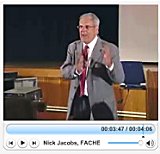In the last three years, I’ve had a flu shot every year, two types of pneumonia shots, a shot for Hepatitis C, one for shingles, and another one for Tetanus and whooping cough, but none of them stop me from becoming disease-ridden with the dreaded flu at least once a season. For the past eight years, I’ve been blaming it on flying in airplanes filled with recirculated coughs and sneezes, but all of my work in the past three weeks has not been in the sky.
OK, I do work in hospitals, those capricious breeding grounds for hundreds of unusual infections, but I’m pretty careful when I’m in those places.
It is always intense. In fact, the intensity of this condition hasn’t changed much in 30 years. The only thing I can figure out is that my childhood allergic asthma attacks, or playing professional trumpet in smoke-filled clubs for 20 years have resulted in some type of permanent damage to my lungs. When even the littlest cold attacks my immune system, it takes every white blood cell that I can muster from my entire body to keep those sniffles from blossoming into full-blown pneumonia. (I’ve had pneumonia about six or seven times, too.)
It was about 10 years ago when a radiologist friend said to me, “Hey, Nick, do you remember breaking your ribs because they’ve definitely been broken.” Did I remember breaking my ribs? The answer to that had to have been, no, but do I remember coughing so much, so hard, so loudly, and so forcefully that the chandelier started to swing? Do I remember the dog hiding in the other room? Do I remember being banned to a Lazy Boy recliner in the basement as my sit-up bed? Yes. I do remember those things very well.
It always starts out the same. There’s a little tickle in my throat that makes me sound like Barry White or some ripped guy with washboard abs at the other end of 1-900 phone number. (Not that I would know how someone like that sounds.) But I do know how Barry White sounds, and he drives the ladies crazy. Then, by the next morning the sneezes, continuous nose dripping, and mild coughing begin. By about 7:30 p.m. that night, I’m fully immersed in humidifiers, neti pots, flannel jammy pants, gallons of fluid, Tylenol, cough drops and cough medicine, tissues, and soft animal pillows to hold against my chest to ease the pain caused as I try not to crack more ribs.
Sometimes I cough so hard it seems like losing consciousness would be a blessing, but it’s only a cold.
In my work in healthcare, it always amazes me that we can do proteomic analytics to determine what proteins are spreading cancer or heart disease. We can look at individual microbes to ascertain what’s happening with our microbiome and digestion. We can look at the 300 genes that control the metabolism of our medications so that we take the right drugs, but we can’t figure out the common cold or flu.
How many times have we heard, “The Centers for Disease Control did not guess correctly on the strain of flu this year for your flu shots?” Good luck with that. I heard this morning that 400 stray cats have been quarantined in a warehouse in New York City because they have a new version of the swine flu. I’m sure I do as well. Too bad I’m allergic to cats, or I’d go hang out there, too. Here kitty kitty kitty.




